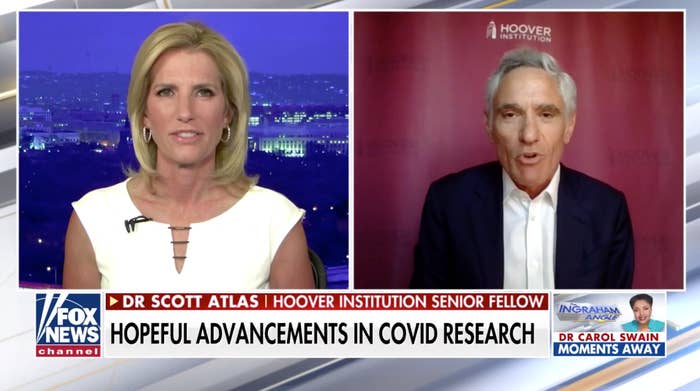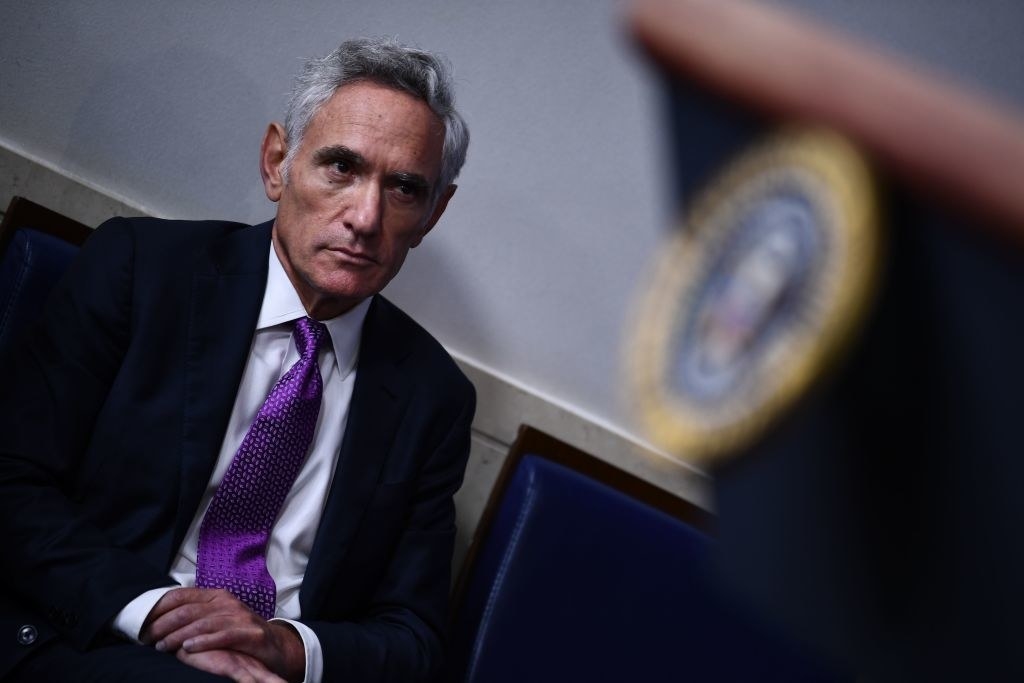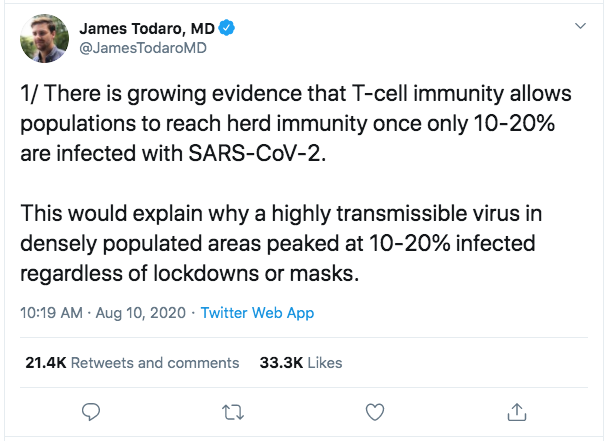
The journalists at BuzzFeed News are proud to bring you trustworthy and relevant reporting about the coronavirus. To help keep this news free, become a member and sign up for our newsletter, Incoming.
How the immune system responds to the coronavirus is a mystery that scientists are working furiously to unravel — but their findings are being weaponized to make unfounded claims that the pandemic isn’t a big threat.
That became clear this week, when President Donald Trump unveiled his newest science adviser on the coronavirus task force, neuroradiologist Scott Atlas. A senior fellow at Stanford University’s Hoover Institution, he has steadily promoted unscientific views about the virus on Fox News and elsewhere, and has said there is “zero excuse to not have the schools open in person.” On Monday, Rush Limbaugh said Atlas was “countering Fauci” and cited the new adviser’s baseless theory that “we could well be burned out of COVID” by October. The reason: “prior immunities.”
Also on Monday, an unlicensed ophthalmologist and cryptocurrency investor, James Todaro, went viral on Twitter with a similarly misleading screed. Todaro, who was in the viral “America’s Frontline Doctors” video shared by Trump and removed from social media platforms for spreading misinformation about hydroxychloroquine, falsely claimed that “T cell immunity” meant many regions were already safe from infection and that lockdowns and mask-wearing were likely useless.
But infectious disease experts say these claims grossly distort the underlying science and what it means for public health guidelines — which, right now, is nothing.
If you have tips related to this story, you can reach this reporter at stephanie.lee@buzzfeed.com or stephaniemlee@protonmail.com.
The apparent basis for these statements: a slew of recent studies finding that, in some places, 20% to 50% of people have immune cells that unexpectedly recognize the coronavirus. The newest of these studies suggests that these cells exist because they have responded in the past to similar viruses that can cause colds.
But the significance of this finding remains an open question, as it’s unclear what role, if any, these cells play in the body’s overall response to the coronavirus. And there is still no evidence that having these cells from a past cold will save you from getting COVID-19.
As T cells become yet another politicized flashpoint, scientists say the bottom line is that none of these findings make COVID-19 any less of a threat. The research should not be used, they warn, to argue against shutdowns and masks or for reopening workplaces and schools in a developed nation that has uniquely failed to control the virus. Most of all, they reject the leap of logic that the research means society is close to herd immunity — the point at which enough people are immune to a virus that it stops circulating.
“We’ve got 1,000 people dying a day in the country,” Shane Crotty, an immunologist at the La Jolla Institute for Immunology who has worked on several of the recent T cell studies, told BuzzFeed News. “There’s no change in what the virus is doing based on what I find out or anybody else finds out. The virus is doing its thing and we’re doing our best to understand it.”
The claim that T cells could mean the pandemic will end in two months, he said, is “a total misunderstanding and wishful thinking.”

Since the outset of the pandemic, Crotty and scientists around the world have been racing to untangle how the virus wreaks havoc on the body and how the body fights back.
The immune system employs different mechanisms to recognize and attack intruders. Perhaps the best-known of the bunch are antibodies, the proteins that latch onto and neutralize viruses and other invading substances. But in people who recover from the coronavirus, antibodies may only protect against reinfection for three months, recent research suggests.
Another weapon in the immune system’s armory is T cells, which come in an assortment of types and functions and are increasingly garnering scientific attention. In the Netherlands, Germany, Singapore, the United Kingdom, and the US, researchers have discovered that in some people, a specific subset of T cells recognized the new coronavirus, SARS-CoV-2, when exposed to it. This was surprising, because these kinds of T cells, by definition, were not expected to recognize a virus they had never encountered before.
In their paper published last week in Science, Crotty and his team reported an explanation for why these cells reacted. Using human blood samples collected prior to the pandemic, they found cells that reacted to both SARS-CoV-2 and to four other coronaviruses that cause common colds. These coronaviruses, the researchers said, were apparently similar enough to the new one to make the T cells “cross-reactive.” (Crotty likened SARS-CoV-2 to “a pretty distantly related evil cousin.”)
The finding has led scientists to speculate that these cross-reactive T cells could be behind one of the pandemic’s biggest mysteries: why the virus causes severe illness in some people but mild or no symptoms in others. The latter patients might be better equipped to handle an infection, having fought off related viruses before. Children’s immune systems have to fight off a lot of colds, so maybe this is why they seem to be relatively spared by the new virus.
For now, however, this theory is just that: a theory.
“It could explain everything and it could explain nothing,” Crotty said. “Very truly, these cells may have no impact on the disease at all.” And even if this theory were borne out, it would have significant limits: As he noted, colds are caused by hundreds of viruses, not just the four identified in the study.
Either way, these cells are still just one piece of the immune system, a highly intricate machine with all kinds of T cells and antibodies working independently and together to stamp out pathogens. The big, yet-to-be answered questions are which of these elements actually protect people from getting sick and for how long.
“While T cells may offer some protection — and that’s not really known — T cells would probably not just prevent a person from being infected altogether,” said Angie Rasmussen, a virologist at Columbia University who is not involved with this research.
But uncertainty hasn’t stopped pundits from twisting the research to make a point.

On July 23, before he was appointed to the White House’s coronavirus task force, Scott Atlas declared on Laura Ingraham’s show that lockdowns would not eradicate the virus, that the US outbreak was “not out of control,” and that “there is absolutely no reason to panic,” arguments he’d been making since the spring. That day, the nation’s case count passed 4 million.
“There’s a lot of great data coming out about immunity,” Atlas went on to say. “It’s probably not known to the public, but there is a lot of data that shows that people have immunity — even people that didn’t get the infection.” He added, “That’s probably due to this T cell immunity,” and concluded, “So I think people should be much more optimistic here.” The Fox News host responded enthusiastically, saying she’d been discussing T cells and what they could mean for herd immunity on the show for “well over six weeks.”
This week, Limbaugh cited Atlas’s theory to tell listeners that the pandemic was almost over. “We could see by early October COVID-19 turn inert or dormant largely due to some underappreciated T cell, prior immunities from exposure to coronavirus, meaning colds and so forth,” the conservative radio host explained. “Some people who have come down with a cold over the course of the summer miraculously end up less likely to get COVID-19, according to Scott Atlas. And people that get colds, that’s a large portion of the population.”
Atlas directed a request for comment to White House spokesperson Judd Deere, who said in a statement that Atlas is “a world renowned physician and scholar of advanced medical care and health care policy” who, “like all of the medical experts in the Administration, is working to carry out the President’s number one priority: protecting the health and safety of the American people.”
Deere added, “We are all in this fight together, and only the media would distort and diminish Dr. Atlas’ highly acclaimed career simply because he has come to serve the President.”
Around the same time Limbaugh was praising Atlas’s theory, a similar claim was gaining traction on James Todaro’s Twitter account. Todaro, an early and avid proponent of hydroxychloroquine, is an ophthalmologist who earned his medical degree at Columbia University. He has not practiced since 2018, according to his LinkedIn profile, and his Michigan medical license expired last year. He did not respond to a request for comment.
In his thread, Todaro claimed that Crotty’s studies and others were growing evidence of “T-cell immunity.” “All those runny noses from the common cold prepared our T cells to fight COVID-19,” he proclaimed. He calculated that if about “50% of people had T cell immunity prior to SARS-CoV-2,” and an additional 10% to 20% of people were newly infected, then 60% to 70% of the population would be immune — a threshold that he said reached “herd immunity.”
“It is likely that many of the hardest hit regions of the world (e.g. Lombardy, NYC, Madrid, London, Stockholm) are now at herd immunity,” he wrote. “Lockdowns & mask ordinances (mostly coming after the peak) likely had little effect, with the exception of perhaps prolonging the spread.”
That’s not at all what the T cell research suggests, however. Having these cells still means you can get infected, only maybe — maybe — not as badly as if you didn’t have them.
“Herd immunity implies immunity, not just fewer people getting severe disease,” said Gideon Meyerowitz-Katz, an epidemiologist at the University of Wollongong in Australia. “That means they do not catch it, do not spread it, they have this immunity that stops them from getting it in the first place.”
Even if 50% of the population really were somehow immune to the virus, that wouldn’t change the number of people who have been hospitalized and killed by the pandemic. As of Friday, the death toll in the US had exceeded 167,000. “It doesn’t change anything from the public health side of things,” Meyerowitz-Katz said.
Nevertheless, Todaro’s 19-part thread has been retweeted more than 48,000 times. It has circulated among figures on the right, from a Minnesota state senator to an editor at the Conservative Review to an ex-lawyer who has been retweeted by Trump. Other retweeters included the World Health Organization’s director of epidemic and pandemic diseases, and a Scottish historian who shared it with his more than 1 million followers: “Interesting thread. And hopeful if true.”
Crotty is not a heavy Twitter user — he checks it about once a week — but he felt compelled to respond once he saw how far the misinformation was spreading. “It was just not understanding the science,” he said.
He banged out a series of counterpoints, explaining why Todaro’s claims were “dangerous” and unfounded. Nothing about his findings, he stressed, should change what the public should already be doing to stem transmission. “Wearing a mask is much more effective than hoping you and the people around you have pre-existing T cell memory. Wearing a mask stops infections.”
His debunk was retweeted more than 3,700 times, a mere fraction of Todaro’s reach.
Rasmussen, the Columbia virologist, worried that most people watching Fox News or coming across Todaro’s tweets would never see Crotty’s attempt to correct the record. As she put it: “They’re just going to look at, ‘Oh, here’s this big thread on T cell immunity. This sounds great. We don’t even need to worry about waiting for a vaccine.’”
And she pointed out that this isn’t the first time during the pandemic that seemingly credible sources have injected misinformation into the mainstream.
“We’ve seen this a few times: People essentially using the clout of their credentials or their affiliations with a prestigious university to get them onto TV basically and amplify these messages,” Rasmussen said. The overarching message, as she saw it, is “the standard Trump administration downplaying of the severity of the pandemic, saying that ‘this is not as a big of a deal as everybody makes it out to be.’ Which, of course, the epidemiological evidence of over 160,000 deaths suggests otherwise.”
During an interview on Wednesday, it was still dawning on Crotty that his research had suddenly, unwittingly, become another political flashpoint.
“2020,” the immunologist said. “The year when all kinds of unexpected things happen.”
